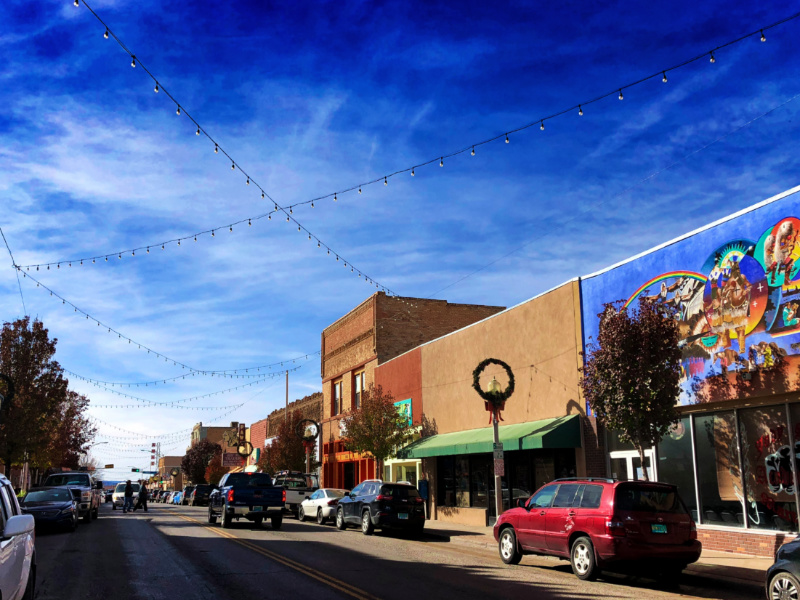Gallup offers an astonishing and unparalleled variety of high quality turquoise and silver jewelry, paintings, murals, pottery and sculptures, rugs and blankets, Kachina dolls and other Native American arts and crafts. This town is the Indian jewelry capital of the world; wares produced in their community supply the art markets of Santa Fe and San Francisco. As the gateway to the Native American culture, Gallup affords easy access to visit Zuni Pueblo and the Navajo Nation. You might experience authentic traditional nightly dances right in Gallup, all of them performed by a variety of area tribes, with traditional drum, rattle and flute instruments.
Hopi katsina figures, also known as Kachina dolls, are
figures carved, typically from cottonwood root, by Hopi people to instruct
young girls and new brides about katsinas or katsinam, the immortal beings that
bring rain, control other aspects of the natural world and society, and act as
messengers between humans and the spirit world.
 |
| A View of Gallup Downtown |
The Gallup area is home to over 1,000 Native American
Artisans creating unique works in jewelry, pottery, basket weaving, rug
weavings, sculptures, unique textiles, paintings, and more.
Founded in 1881 as a headquarters for the southern
transcontinental rail route, Gallup has become the gateway to the Native
American cultural experience and a center for Native American arts. Visit the
local museums to learn more about Gallup history, Native American art &
culture as well as the Navajo Code Talkers.
 |
| Main Entrance to the Gallup Cultural Center |
The Gallup Cultural Center was created in 1996 at the newly
renovated Santa Fe Depot by the Southwest Indian Foundation. The concept for
the Cultural Center is modeled on the Public Square, where the community,
school children and visitors can gather together for forums, lectures and to
celebrate the extraordinarily diverse heritages of our region.
The exhibits at the museum of the Gallup Cultural Center
(located on the 2nd floor of the building- the Storytellers Museum) showcase
the museum’s traditional approach to the interpretation of Native American Arts
& Culture. Developed through active partnership between Native and
non-Native people, the museum's exhibits convey the message that Indian
cultures are complex diverse, steeped in Tradition and very much alive. There
are also unique train models for the public that give a sense of Gallup's rich
train history.
The Gallup Cultural Center is now home to Gallup's Navajo
Code Talker Exhibit.
 |
| The Red Rock State Park |
Several archeological sites here record the presence of the
Ancestral Puebloans, a prehistoric farming culture that developed and thrived
in the area from 300 to 1200 CE. From 1700 to the present, members of the
Navajo tribe have sparsely inhabited the region.
Through interpretive exhibits, the Red Rock Museum
chronicles the lives and culture of the Ancestral Puebloans as well as the
present-day Zuni, Hopi and Navajo.
 |
| Advertisement |
Directions to the museum are not difficult to follow. As you
come from I-40 East, take exit 33 and proceed west on the frontage road for 4.5
miles. Follow signs into Red Rock Park. The museum is located west of the
Convention Center main doors next to the office. If, on the contrary, you come
from I-40 West, then take exit 26 and proceed east on NM 118 for 2
miles. Follow signs into Red Rock Park. The museum is located west of the
Convention Center main doors next to the office. Do you use a GPS? Set the
address 825 Outlaw Road, but once in the park follow the left road at the fork,
not the right. 825 Outlaw Road is located inside the Campground area, and the
museum is on the other road.
 |
| Sign of the Rex Historical Museum |
 |
| Gallup at Night |
Gallup Express provides local transportation in Gallup and
Zuni, as well as intercity service between the two towns. Navajo Transit provides regional transportation within the Navajo Nation. Greyhound provides intercity transportation. The local Greyhound station is located at the Route 66 Mini Mart at 3060 West Highway 66. Amtrak provides daily service from Gallup to the Grand Canyon, Los Angeles, Albuquerque and other destinations via Amtrak's Southwest Chief. The station is located in the Gallup Cultural Center at 201 East Highway 66. Gallup lies along U.S. Interstate 40, one of the major transcontinental East-West thoroughfares, between Albuquerque, NM and Flagstaff, AZ. U.S. Highway 491 (north) and N.M. Highway 602 (south) provide additional access to the Gallup area. As reference, Albuquerque is located 136 miles east of Gallup or about 4 hours of drive.
|
|















